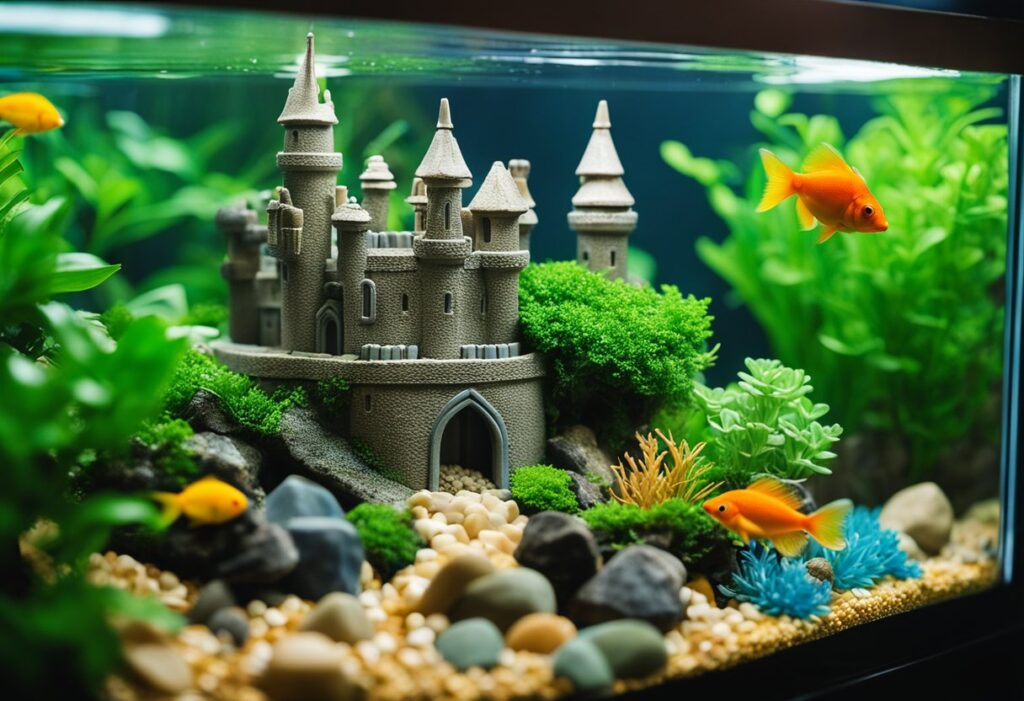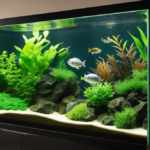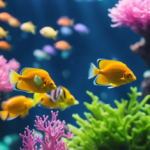Are you a beginner looking to start an aquarium? Fish tanks can be a great way to bring life and color into your home, but they do require some knowledge and effort to maintain. In this article, we will guide you through the process of choosing the right fish tank, setting it up, and maintaining it to ensure your fish and plants thrive.

Choosing the right fish tank is the first step in creating a successful aquarium. The size of your tank will depend on the space you have available and the type of fish you want to keep. A larger tank is generally easier to maintain and provides more room for your fish to swim, but it also requires more equipment and can be more expensive. We will discuss the pros and cons of different tank sizes and materials to help you make an informed decision.
Setting up your aquarium can seem daunting, but it doesn’t have to be. We will walk you through the process of adding substrate, water, and decorations to your tank, as well as installing and maintaining the equipment necessary for your fish to thrive. We will also cover the importance of water quality and maintenance, and provide tips on how to keep your aquarium clean and healthy for your fish and plants.
Key Takeaways
- Choosing the right fish tank is crucial for a successful aquarium.
- Proper setup and maintenance are necessary for the health of your fish and plants.
- Water quality is key to a thriving aquarium, and regular maintenance is necessary to keep it clean and healthy.
Fish Tanks For Beginners
| Product Name | Rating | Price |
|---|---|---|
| Nano Aquarium Starter Kit – 3 Gallon | 5.0 | $84.99 |
| SANOSY 4 Gallon Amazonian-Themed Kit | 4.7 | $59.99 |
| GloFish Betta Shadowbox Aquarium Kit | 4.5 | $59.99 |
| Marina 5 Gallon LED Aquarium Kit | 4.4 | $74.46 |
| MarineLand Portrait Glass LED Kit – 5 Gallon | 4.4 | $79.99 |
| MarineLand Contour Glass Kit with Rail Light | 4.4 | $67.04 |
| Tetra ColorFusion 20 Gallon Aquarium Kit | 4.4 | $147.22 |
| Aqueon Aquarium 20 Gallon High Fish Tank Kit | 4.4 | $158.42 |
| QANVEE Betta Nemo 2 Gallon Fish Tank | 4.4 | $49.99 |
| PONDON 5 Gallon Rimless Glass Aquarium Kit | 4.3 | $89.99 |
| Penn-Plax Water-World Vertex 2.7 Gallon Kit | 4.3 | $65.00 |
| Tetra Complete LED Aquarium 10 Gallon | 4.3 | $99.49 |
| Tetra LED Half Moon Aquarium Kit – 1.1 Gallons | 4.2 | $20.02 |
| Tetra ColorFusion Starter Kit – 3 Gallons | 4.2 | See options |
| Aqueon LED MiniBow Kit with SmartClean – 2.5 Gallon | 4.2 | Click to see price |
| Aqueon LED MiniBow Kit with SmartClean – 5 Gallon | 4.2 | Click to see price |
| Koller Products AquaView 6-Gallon 360 Kit | 4.2 | $79.99 |
| Aqueon LED MiniBow Kit with SmartClean – 1 Gallon | 4.1 | $35.97 |
| Tetra Bubbling LED Aquarium Kit – 1 Gallon | 4.1 | $35.00 |
| GloFish Betta Aquarium Kit – 1.5 Gallons | 4.1 | $35.29 |
| Koller Products AquaView 4.5-Gallon Starter Kit | 4.1 | $58.80 |
| Hygger Horizon 8 Gallon LED Glass Aquarium Kit | 4.1 | $135.00 |
| Aqueon LED MiniBow Aquarium Kit – 2.5 Gallon, White | 4.0 | $58.99 |
*Please note that prices are subject to change and may vary depending on the seller, location, and any applicable discounts or promotions. The ratings provided are based on customer reviews and may also change over time. Amazon Affiliate Link.
Choosing the Right Fish Tanks

When it comes to choosing the right fish tank, there are a few factors to consider. In this section, we’ll discuss the differences between glass and acrylic tanks, as well as understanding tank size and location.
Glass vs. Acrylic Tanks
The two most common types of fish tanks are glass and acrylic. Glass tanks are more affordable and scratch-resistant, while acrylic tanks are more durable and lightweight. However, acrylic tanks are also more expensive and can be easily scratched if not handled properly. Ultimately, the choice between a glass and acrylic tank will depend on your budget and personal preferences.
Understanding Tank Size and Location
When choosing a fish tank, it’s important to consider the size and location of the tank. The size of the tank will depend on the number and size of fish you plan to keep. As a general rule, it’s recommended to have one gallon of water per inch of fish. This means that a 20-gallon tank can comfortably house up to 20 inches of fish.
In addition to tank size, it’s also important to consider the location of the tank. Fish tanks should be placed in an area that is away from direct sunlight and drafts. Direct sunlight can cause algae growth and temperature fluctuations, while drafts can cause temperature fluctuations and stress to your fish.
Overall, when choosing a fish tank, it’s important to consider your budget, personal preferences, and the needs of your fish. By taking these factors into consideration, you can choose a fish tank that is perfect for you and your fish.
Setting Up Your Aquarium
Essential Equipment
Before starting with the setup process, it’s essential to have the right equipment in place. Here’s a list of the essential equipment that you’ll need to set up your aquarium:
- Filter: A filter is crucial to maintain the water quality in your aquarium. It helps to remove debris and waste, keeping the water clean and healthy for your fish.
- Lighting: Lighting is essential for the growth of plants in your aquarium. It also helps to create a natural environment for your fish.
- Hood: A hood is necessary to prevent fish from jumping out of the tank and to reduce evaporation.
- Stand: An aquarium stand is necessary to provide a stable base for your aquarium. It should be strong enough to support the weight of the tank and the water.
- Heater: A heater is necessary to maintain the water temperature in your aquarium. It helps to create a comfortable environment for your fish.
- Substrate: Substrate is the material that you put at the bottom of your aquarium. It helps to create a natural environment for your fish and plants.
Step-by-Step Setup Guide
Now that you have all the essential equipment, it’s time to set up your aquarium. Here’s a step-by-step guide to help you through the process:
- Choose the right location: Select a location for your aquarium that is stable, away from direct sunlight, and heavy traffic areas to avoid stress to the fish and potential accidents. It should also be near an electrical outlet.
- Assemble the stand: If you’re using an aquarium stand, assemble it according to the manufacturer’s instructions.
- Install the filter, heater, and lighting: Follow the manufacturer’s instructions to install the filter, heater, and lighting. Make sure that they are working correctly before moving on to the next step.
- Add substrate: Add substrate to the bottom of your aquarium. Make sure that it is evenly spread and level.
- Fill the tank with water: Fill the tank with water, but leave a few inches of space at the top to prevent water from overflowing.
- Install the hood: Install the hood to prevent fish from jumping out of the tank and to reduce evaporation.
- Cycle the tank: Before adding fish to your tank, you need to cycle it to establish beneficial bacteria that help to maintain water quality. This process can take several weeks.
If you’re looking for a complete aquarium kit, some of the popular options for Fish Tanks For Beginners include Fluval Spec V Aquarium Kit, Marineland Portrait Glass LED Aquarium Kit, BiOrb Classic Aquarium, and Marina LED Aquarium Kit. These kits come with all the essential equipment you need to set up your aquarium.
Water Quality and Maintenance
As beginner aquarists, we need to understand the importance of maintaining good water quality in our fish tanks. Poor water quality can lead to stress, disease, and even death of our fish. Therefore, we need to be aware of the different aspects of water quality and how to maintain it.
Cycling and Water Chemistry
Before adding fish to our freshwater aquarium, we need to cycle the tank. Cycling the tank means taking the necessary steps to bring the water conditions up to where they are healthy for the fish. This involves establishing beneficial bacteria in the filter media, which helps break down ammonia and nitrite into less harmful nitrate. We can use a test kit or test strips to monitor the levels of ammonia, nitrite, and nitrate in the water. Ideally, we want ammonia and nitrite levels to be at 0 ppm, and nitrate levels to be below 40 ppm.
It is also important to maintain the pH levels, alkalinity, and hardness of the water. The ideal pH level for most freshwater fish is between 6.5 and 7.5. We can use a water conditioner to adjust the pH levels and remove chlorine and chloramine from tap water. Additionally, we can add a dechlorinator during water changes to neutralize chlorine and chloramine. Hardness is the measure of dissolved minerals in the water, and it can affect the health of our fish. We can use a test kit to monitor the hardness of the water and adjust it accordingly.
Routine Care and Water Changes
In addition to cycling the tank, we need to perform routine care and water changes to maintain good water quality. We should test the water parameters regularly and perform partial water changes of 10-20% every 1-2 weeks, depending on the size of the tank. During water changes, we should use a siphon hose or gravel vacuum to remove debris and waste from the substrate. We can also use an algae scraper or pad to remove any algae growth on the glass.
When performing water changes, we should also add a water conditioner and dechlorinator to the new water before adding it to the tank. This helps to neutralize any harmful chemicals in the tap water and maintain the pH levels. We can use a test kit to monitor the water parameters after a water change to ensure they are within the appropriate range.
In summary, maintaining good water quality in our fish tanks is crucial for the health and well-being of our fish. We need to cycle the tank before adding fish, monitor the water parameters regularly, and perform routine care and water changes to maintain the water quality. By doing so, we can provide a healthy and thriving environment for our fish.
Fish and Plant Care

Choosing Beginner-Friendly Species
When it comes to selecting fish for your aquarium, it’s important to choose species that are beginner-friendly. Some of the best options include Tetras, Guppies, and Danios. These fish are easy to care for and can adapt to a wide range of water conditions. They are also peaceful and can coexist with other fish in the tank.
When selecting plants, it’s important to choose species that are compatible with your fish and tank conditions. Some of the best options for beginners include Java Fern, Anubias, and Amazon Sword. These plants are easy to care for and can thrive in a variety of water conditions.
Feeding and Nutrition
Feeding your fish a balanced diet is essential for their health and well-being. Most pet fish require a diet that is high in protein and low in fat. It’s important to choose a high-quality fish food that provides all the essential nutrients that your fish need.
Marina and Tetra offer a variety of fish food options that are specifically designed for different types of fish. It’s important to choose a food that is appropriate for the species of fish that you have in your tank.
In addition to fish food, it’s also important to provide your fish with a varied diet. This can include live or frozen foods such as brine shrimp or bloodworms. Providing your fish with a varied diet will help ensure that they receive all the essential nutrients that they need to thrive.
Overall, proper fish and plant care is essential for maintaining a healthy and thriving aquarium. By choosing beginner-friendly species and providing your fish with a balanced diet, you can ensure that your aquarium remains a beautiful and enjoyable addition to your home.
Accessories and Decorations

When it comes to setting up a fish tank, accessories and decorations are important to consider. These items not only make the tank look more visually appealing, but they also provide a more comfortable and healthy environment for your fish. In this section, we will discuss lighting and heating options, as well as creating an aesthetic environment.
Lighting and Heating Options
Lighting and heating options are important for maintaining a healthy environment for your fish. LED lighting and fluorescent lighting are both popular options for fish tanks. LED lights are energy-efficient and can last for a long time, while fluorescent lights are affordable and provide a good amount of light. Metal halide lights are also an option, but they tend to be more expensive and are not necessary for most fish tanks.
For heating, electric heaters are the most common option. They are easy to use and maintain a consistent temperature in the tank. It is important to choose a heater that is the appropriate size for your tank. A good rule of thumb is to choose a heater that can heat the water to 5-10 degrees above room temperature.
Creating an Aesthetic Environment
Decorations are an important part of creating an aesthetic environment for your fish tank. Not only do they make the tank look more visually appealing, but they also provide hiding places and shelter for your fish. When choosing decorations, it is important to consider the size of your tank and the type of fish you have. Large decorations can take up too much space in a small tank, while small decorations may not be visible in a large tank.
Some popular decorations include plants, rocks, and driftwood. Live plants not only look great, but they also help to oxygenate the water. Rocks and driftwood can provide hiding places and shelter for your fish. It is important to choose decorations that are safe for your fish and won’t harm them.
In addition to decorations, supplies such as fishnets and canister filters are also important to have on hand. Fishnets are useful for removing debris from the tank, while canister filters help to maintain a clean and healthy environment for your fish.
Overall, accessories and decorations are important for creating a healthy and visually appealing environment for your fish. By considering lighting and heating options, as well as choosing appropriate decorations and supplies, you can create a beautiful and comfortable home for your fish.





